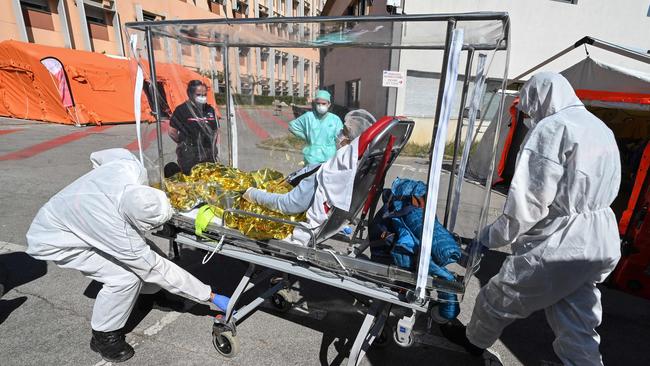Coronavirus: solving a puzzle with the world looking over their shoulders
As doctors see more and more of COVID-19, they are getting a handle on what the coronavirus does to people.

But the why of this is another matter.
Four months and more than two million cases worldwide into the pandemic, with deaths numbered in the hundreds of thousands, questions outweigh the few, hard-won answers gleaned from the hit-and-miss of patient care and preliminary lab studies.
A vaccine, the only sure way to stop the disease, is at least a year away and for all the optimism of the researchers nobody can be sure one will emerge. Several repurposed drugs show promise as treatments but they, too, have a long way to go before being proven. For now, Australians can take comfort that the stopgap of border closures, shutdowns and social restrictions are working better than just about anywhere else.
But as the clamps come off in the coming months — assuming the spread of infection continues to be controlled — understanding the ins and outs of the virus, its strengths and weaknesses, will become even more vital in the absence of a vaccine.
Take the best-known feature of COVID-19; lethality to the elderly. From the time the first cases were identified in the Chinese city of Wuhan in December last year, deaths skewed overwhelmingly to the over-70s. No surprise there. Sorry, boomer, but the healthiest septuagenarian still has the immune system of, well, a septuagenarian. What puzzled doctors and scientists were the ancillary outcomes. Babies, small children and pregnant women usually rank with the elderly as the most vulnerable in an epidemic. Yet from day one, COVID-19 largely spared them, as well as teenagers and to a lesser degree young adults. A study of 72,314 patient files in central China’s Hubei province, enfolding Wuhan, found that fewer than 10 per cent of those infected were under 30.
The gender disparity has proved to be even more mystifying. In Italy, men account for 60 per cent of cases and 70 per cent of all deaths, again weighted heavily to the grey and white-haired cohort. New York City counts 43 COVID-19 fatalities for every 100,000 men against 23 per 100,000 women, according to its health department.
Here, the story is much the same. Of Australia’s 63 fatalities to date, 37 have been men, just one aged under 60. Interestingly, the number of young women infected is considerably higher in the 20 to 30 age bracket — more than 750 to about 600 men — something that has epidemiologists thinking about smoking. Could it be the missing link?
At first glance, this makes sense. COVID-19 starts as an upper respiratory infection, the virus lodging in the throat and nasal passages, but in its severest form it settles in the lungs to choke oxygen supply, eventually damaging other organs. Men also have higher rates of hypertension, a related risk factor. If an individual has pre-existing pulmonary and/or cardiovascular problems arising from smoking, it stands to reason they would have a tougher time of it.
The theory gained early traction in China because the difference in smoking rates between the sexes there is striking: 61 per cent of men to barely 4.2 per cent of women, according to the World Health Organisation.
However, in wealthy Western societies the discrepancy is much less pronounced: 16.5 per cent of men and 11.1 per cent of women smoke daily in Australia. And here’s the problem when it comes to extrapolating the data to COVID-19: contrary to popular belief, the gender gap widens when it comes to young adults smoking. In 2018, men aged 18 to 24 led their female peers 17.5 per cent to 10.4 per cent in regularly using tobacco products, the Australian Bureau of Statistics reports. So smoking may be part of the jigsaw but it doesn’t solve the puzzle, not here anyway.
Katherine Gibney of the Peter Doherty Institute for Infection and Immunology in Melbourne, where epidemiologists are modelling the epidemic for the federal government, cautions against drawing conclusions off a thankfully low base of cases in this country. “Certainly in China it was bit easier to put it down to things like smoking because there was a big gender disparity in smoking there,” she says. “That is not the case in other countries. If you look at some studies of disease burden in Australia they do say there is more disease caused in men than women … but I don’t think there is one clear single reason.”
The answer may lie in the immune system itself, how it works differently in men and women, coupled with other compounding factors. Gibney, an infectious diseases physician and medical epidemiologist, says this is apparent with several diseases. It may be that behaviour increases the exposure of men to a particular virus — as is the case with HIV.
Then there is tuberculosis. Men are twice as likely to catch that deadly lung disease because the genes on their lone X chromosome interact differently with the predatory mycobacterium than the double-X combination in women. This can also be a double-edged sword for women, making them more prone to auto-immune diseases such as rheumatoid arthritis and lupus when a hyper-immune response is triggered. Talk about swings and roundabouts. The thinking with COVID-19 is that a more robust immune reaction works for women, empowering their body’s defences to go after the pathogen.
“In very general terms, women’s immune systems may get on top of the disease more effectively than men,” Gibney says.
Another theory scientists are pursuing is that the receptor the coronavirus uses to bind to human cells — known as ACE2, for angiotensin converting enzyme 2 — is more prevalent in older people or shaped in a way that assists it, increasing the patient’s susceptibility. In severe illness, the virus seems to trigger an explosive immune over-response in which proteins called cytokines are rapidly released into the bloodstream, clogging the lungs and compromising other organs in a grim struggle for survival where the person’s odds are at best 50-50.
As for children, there is no explanation for why they generally experience milder symptoms or none at all, a feature of other diseases caused by coronaviruses, such as severe acute respiratory syndrome and Middle East respiratory syndrome. One theory holds that their immune systems, being less developed, don’t have the capacity to overreact and unleash a cytokine storm. Gibney says there is always the possibility that childhood vaccinations confer some cross-immunity to COVID-19. Even though children appear less likely to become dangerously sick, they aren’t insulated from the virus.
“They get the infection, but they don’t seem to be important to spreading it on to others and in most cases they don’t get severe disease,” Gibney says.
She points to another redeeming quality of the virus: its genetic stability. To date, there is no sign that it is as prone as influenza is to mutate, which would compound the already formidable challenge of developing a vaccine and therapeutics.
Perversely, Australia’s achievement in “flattening the curve” of the pandemic serves to underline how dangerous COVID-19 is. With a mortality rate of less than 1 per cent here, it pales against the lethality of MERS, which kills more than a third of those struck by it.
But that’s not the number that counts in pandemic modelling. The R0 — pronounced R-nought — is the basic reproductive number used by epidemiologists to predict how many people will be infected when an epidemic takes hold. COVID-19’s R0 is 2.5. That means 10 carriers will infect 25 others, who will infect 62 more people and so on, increasing exponentially at nearly twice the rate of seasonal flu unless checked.
The good news is the shutdown of borders, workplaces and social activity in Australia has pushed the effective reproductive rate of the virus below 1, a manageable level. Lest we get carried away, Gibney says the danger is far from over. In one sense, COVID-19 would pose less of a collective threat if it killed more people sooner. Yes, it’s a bit to get the head around. But there’s no place for the human heart in these calculations, as Australians will learn in the coming months. “It almost seems like a perfect storm as a disease,” Gibney tells Inquirer.
“It’s reasonably infectious and it causes mild disease in most people, so most people are well enough to be out and about … doing their own thing and spreading it to more people. If it was more like SARS, it would actually be easier to contain … because the majority of people would be much sicker and they would not be going out and spreading it.
“So what we have to learn to live with until a vaccine turns up … is that this virus is a very effective reproducer and very effective at infecting and spreading through communities. We can’t afford to underestimate it at any point.”




As doctors see more and more of COVID-19, they are getting a handle on what the coronavirus does to people. It hits seniors much harder than young adults; kills many more men than women; and is inexplicably gentle on children.